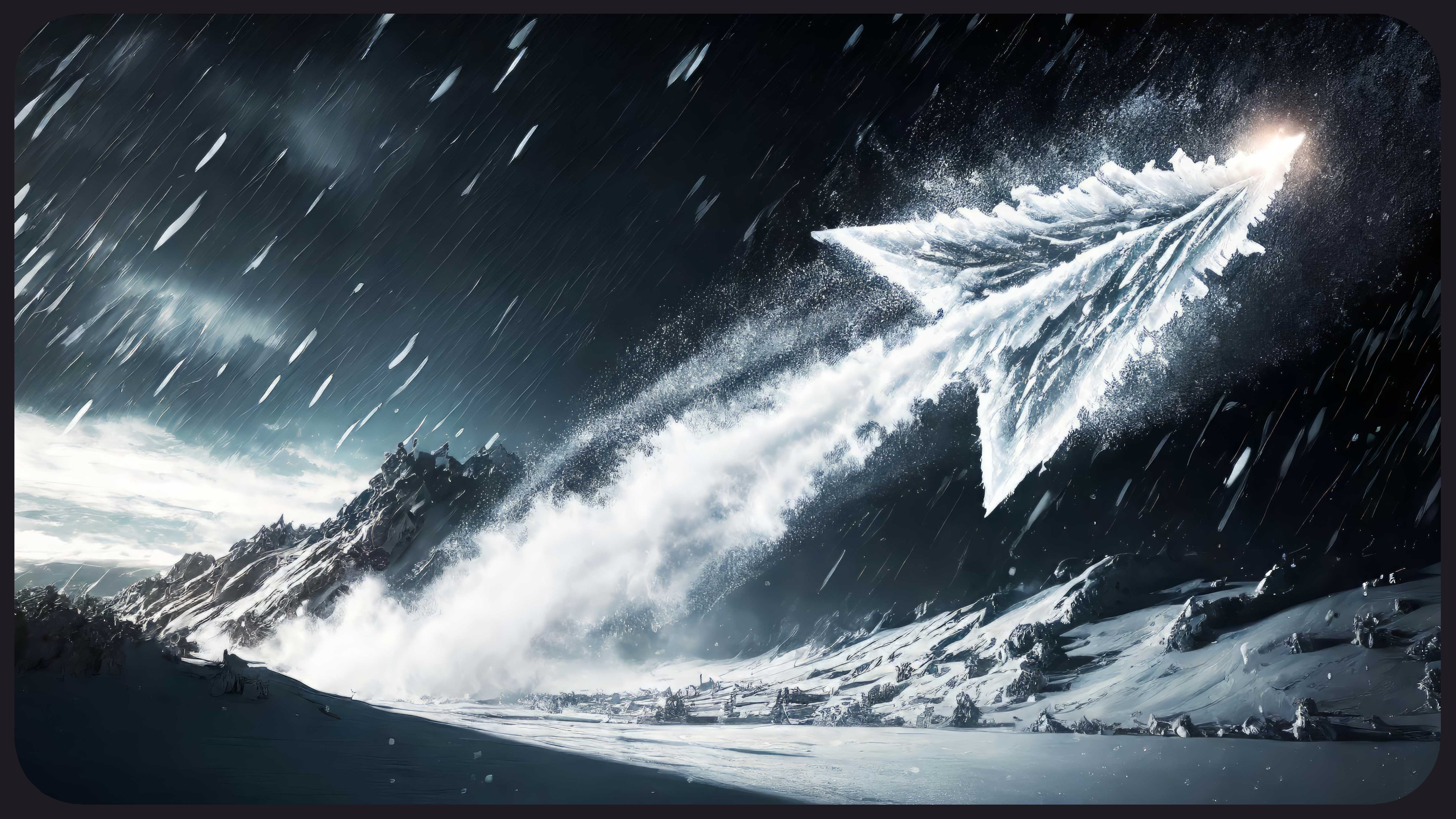Cryomancy
Keep chill and freeze on. Lucrative magic. Doubly so if you pair up with an enchanter.
Cryomancy is an evocation discipline focused on the manipulation of water and ice. Its antipode is pyromancy. Wizards debate whether cryomancy is an appropriate name because of philosophical disagreement regarding its role in thermodynamics or because cryomancy 'sounds better.' (Technically, cryomancy affects temperature and the state of water is an obvious manifestation of this change.) Cryomancy spells span from the simple freezing of a cup of water to ice sculpting or drawing water out of the air itself. As a '-mancer' discipline, it is effective in battle, but is arguably the most profitable magic due to the high demand for cooling, frozen foods, iced cream, and clothes that actively combat humidity and heat.
 In general, evocation mana structures are associated with a spin, speed, and geometric shape. Cryomancy does not prioritize either spin or velocity, but incorporates both attributes into an even blend. The mana structure of cryomancy is a rotating cylinder evoked in front of the wizard that (were it a wheel) would 'roll into' the caster. While not fully understood, this rotation forces a drop in temperature whereas the counter-rotation causes a rise (that is, pyromancy). Without careful control and practice, the cylinder breaks and exposes the wizard (and those nearby) to cryomantic effects. Thus, concentration and a degree of safety are paramount.
When evoking the cylinder, a cryomancer uses the mana vectors in their hands and an exhalation of mana from their breath. Gesticulating hand-over-hand in the shape of the cylinder and bringing in the exhaled mana at the bottom of the rotation is recommended for maximum efficiency. Though wizards attempt to augment this method to improve spell power (and find gestures that aren't jokingly referred to as 'the cryo shuffle'), few optimizations have been found.
Range is a key limitation in cryomancy. The conclusion of a cryomancy spell is to 'shove' the cylinder forward, but mana cylinders behave similar to physical cylinders in two ways. First, differences in rotation speed at either end of the cylinder turns it away from the intended path (another reason why concentration is key). Second, without a strong shove, the cylinder can 'roll back' into the wizard (and their allies). Military commanders make concerted efforts to conscript only experienced cryomancers into their units until novices have proven themselves as at least adequate.
In general, evocation mana structures are associated with a spin, speed, and geometric shape. Cryomancy does not prioritize either spin or velocity, but incorporates both attributes into an even blend. The mana structure of cryomancy is a rotating cylinder evoked in front of the wizard that (were it a wheel) would 'roll into' the caster. While not fully understood, this rotation forces a drop in temperature whereas the counter-rotation causes a rise (that is, pyromancy). Without careful control and practice, the cylinder breaks and exposes the wizard (and those nearby) to cryomantic effects. Thus, concentration and a degree of safety are paramount.
When evoking the cylinder, a cryomancer uses the mana vectors in their hands and an exhalation of mana from their breath. Gesticulating hand-over-hand in the shape of the cylinder and bringing in the exhaled mana at the bottom of the rotation is recommended for maximum efficiency. Though wizards attempt to augment this method to improve spell power (and find gestures that aren't jokingly referred to as 'the cryo shuffle'), few optimizations have been found.
Range is a key limitation in cryomancy. The conclusion of a cryomancy spell is to 'shove' the cylinder forward, but mana cylinders behave similar to physical cylinders in two ways. First, differences in rotation speed at either end of the cylinder turns it away from the intended path (another reason why concentration is key). Second, without a strong shove, the cylinder can 'roll back' into the wizard (and their allies). Military commanders make concerted efforts to conscript only experienced cryomancers into their units until novices have proven themselves as at least adequate.

Cryomancy Mana Structure

Cryomancy by SK Kage (via Firefly)
Cylinder Characteristics and Effects
A wizard's first attempts at cryomancy are arranged for summertime because mishaps in evocation are more easily swept away by the heat. Basic cryomancy spells are not complex, but require fundamental understanding of the balance between cylinder characteristics. Mathematically, cryomancy cylinders are 'cropped cylinders' where the front or back of the rotating mana structure is narrower than the other. There are four aspects of cryomancy spells:- Mana Flow: Pushing the mana inside the cylinder as fast as needed.
- Cylinder Radius: Setting the 'height' of the cylinder to change the power of the spell.
- Cylinder Width: Setting the 'width' of the cylinder to increase or decrease the area of effect.
- Front-to-Back Ratio: Controlling the 'cropping' of the cylinder to modify shape.
Cryomancy Verbal Component
Evocation spells, aeromancy included, rarely require overly complex verbal components to be cast effectively. Generally, cryomancers try to minimize the number of variables and limit the length of chants.
Cryomancy by SK Kage (via Firefly)
Physics Manipulation
No wizard has found a way to stop 'roll back' through physics manipulation (or every cryomancer would do so). Instead, most cryomancers begin their chant by altering gravity. Exceptions exist, such as in siege warfare, but cryomancy spells will avoid gravity where possible. The chant also aims to enhance the effects of thermodynamics to transform the spell into a colder state. A suitable balance of chant and rotation manifests a similar chill, but with lower mana expenditure than pure rotational speed.Concentration
Cryomancers tend to eschew modifying the spell concentration. This is not because it isn't useful, but because it adds another factor to manage and there are already enough ways for a cryomancy spell to backlash. However, masters of the discipline define concentration changes over their spells' path. In combat, packaging a spell as it travels and then expanding it rapidly avoids collateral damage. This also maintains mana in the cylinder for a longer distance.Direction and Guidance
Exceptionally skilled cryomancers do not bother with verbal guidance components because they manipulate the rotation along the cylinder's axis to direct the spell around corners and through basic turns. For the average cryomancer, the chant ensures the spell stays on target despite any mistakes in mana structure consistency. Although it is mana- and time-efficient to adjust the cylinder itself instead of through the chant, adding complexity to the cylinder is more likely to result in a backfire than a positive outcome.Fenwick's Freeze-Air
Last summer recorded the highest temperatures on record and if you didn't have a Fenwick's Freeze-Air, you don't know what you're missing! Half their revenue comes from the military. No qualms greasing palms.Evocation Disciplines
Written by Sheyla Enelladalcol Aeleat
Edited by Shikya Enelladalcol Aeleat
Mindcepts by Ella Enelnasalcol Malric
Edited by Shikya Enelladalcol Aeleat
Mindcepts by Ella Enelnasalcol Malric
and Alvix Tuvar



Comments